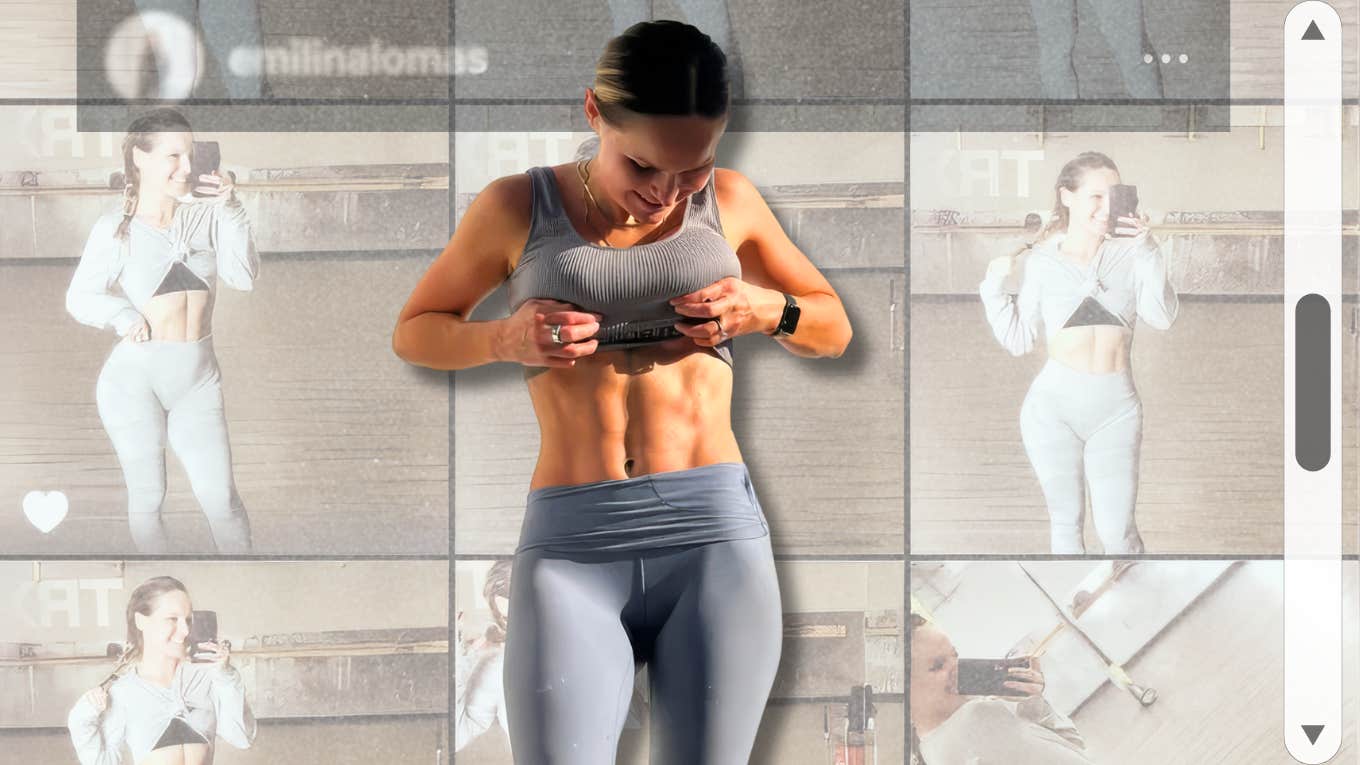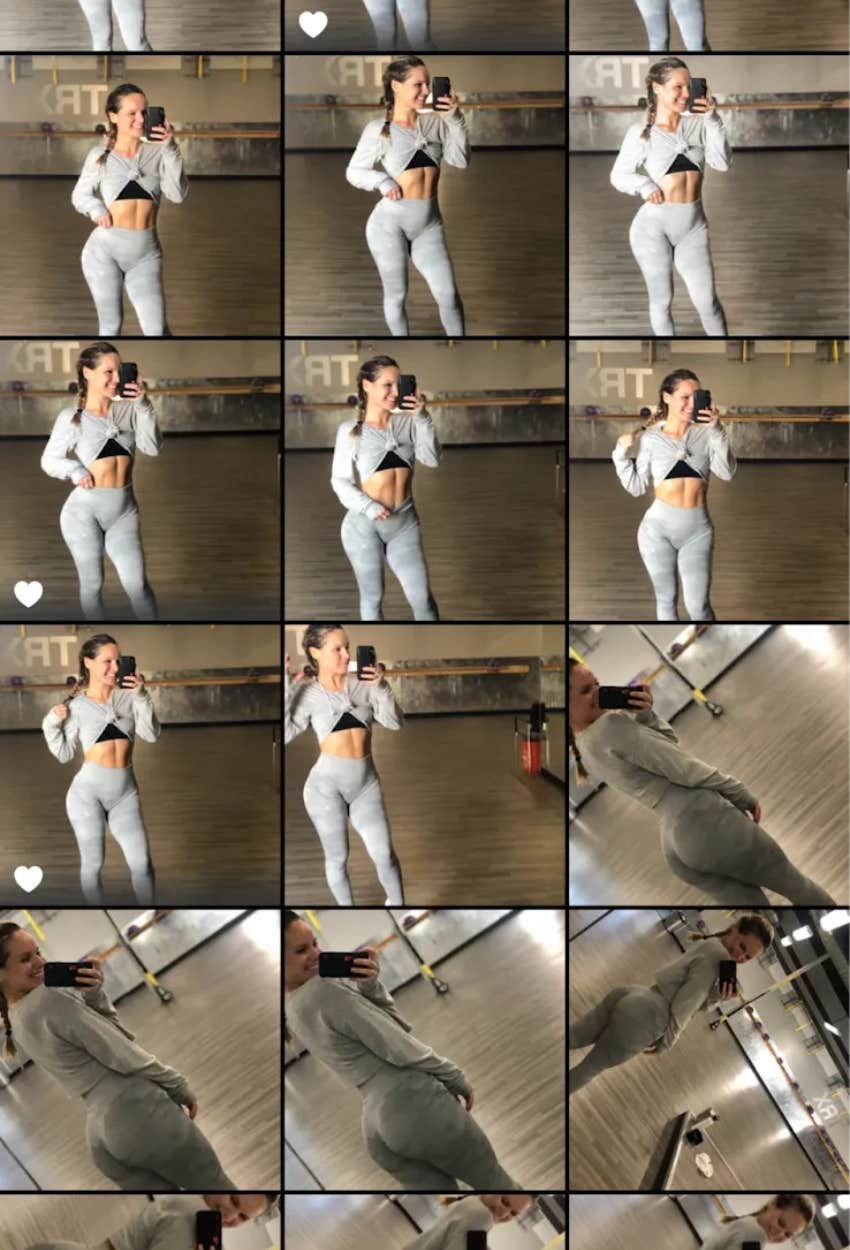Wellness Guru Reveals 11 Things She'd Do Differently If She Restarted Her Fitness Journey
I wasted many years not progressing so you don’t have to.
 Courtesy Of Author
Courtesy Of Author I’ve had a regular fitness routine for a decade now. I’ve gone through a multitude of phases based on the latest research, anecdotes, and random self-experimentation.
Some phases propelled me forward to a healthier and happier version of myself (the goal of any fitness journey, right?). But there have also been phases that have pushed me far back, almost wiping away years of progress.
This is my advice on what to avoid if you want to make progress more consistently on your fitness journey.
Here are 11 things a wellness guru would do differently if she restarted her fitness journey:
1. Don’t listen to people just because they look good
I watched Freelee the banana girl. If you know anything about that content creator, you’ll know exactly why I’m now advocating for avoiding listening to people online.
Her YouTube videos infiltrated my brain before my prefrontal lobe developed. She was a beautiful and fit girl living the ~ natural way ~ and consuming about 15 bananas a day. I gave it a try. I’ll just say it didn’t work out and leave it at that.
While there may be an extremely select number of people who share fitness information online who are actually qualified to do so, the majority of people are loud yet incompetent. Now, from the perspective of a skeptic, I observe the sheer number of influencers and everyday Joes who share their opinions about nutrition, exercise, and wellness with their audience as though they were indisputable facts.
Here’s the truth: Even randomized controlled trials, the gold standard of scientific research, can get it wrong. Moreover, even those high-quality findings may not ring true for you. We’re all different. Some people thrive on a carnivore diet while marathon training, while you might perform best on a Pilates-only workout plan, eating a vegan diet.
I’d go as far as to say, in 90% of instances, don’t listen to people’s advice. Sometimes that’s especially true if they look good. It may be luck of the draw, and their aesthetics are skewing your ability to be rational.
2. Take progress pictures once a month maximum
For some reason, when fitness influencers started gaining traction on social media, their advice always centered around using your social media to document your progress. That often entailed weekly, or even daily, progress pictures, usually published for the fitness world to critique.
This may look like straightforward vanity, but I’d dread my self-prescribed progress check-in day. I’d take pictures from every angle and then go on the photo collage app to compare a side-by-side to the previous week, month, year, etc.
 All photos courtesy of author
All photos courtesy of author
You don’t have to take progress pictures to track your progress. Not to sound like a therapist, but how do you feel? Do you feel stronger, more energized, less out of breath? Are you sleeping better? Are your trousers looser?
Unless you are training for a physique competition, there’s really no need to track the way your body looks. Sure, an occasional snap can be a good indication of the direction you’re moving in. But progress takes time. All you can control is what you do today.
3. Mobility work is more important than most things
I was a notorious stretch-skipper. I’d finish my final set and walk out of the gym quicker than it took for the song I was listening to, to finish. The result? Extremely tight hamstrings, a herniated disc, and terrible spinal extension.
Look, most of the research shows that stretching won’t make you magically stronger. But you’ve got to look at things long-term.
When I started lifting properly, I was around 20. I’m now a parent of two (one bun still in the oven), and approaching 30. My herniated disc has led to pregnancy pain and my tight pelvic floor actually caused issues during childbirth. It’s not just about childbirth, though, it’s an insight into what may come in the future.
I want to be the 70-year-old still competing in Turkey trots. I want to be able to get out of my chair by myself when I’m at the nursing home. I want to live a long healthy, and mobile life. That’s why we exercise, right? Yet it’s too easy to forgo the mobility routine. Don’t.
4. Don’t sweat the small stuff — a 1% performance enhancer is not major
I used to spend hours reading research, listening to podcasts, and watching YouTube videos and documentaries about niche fitness topics.
For example, I remember going down a rabbit hole on protein timing. This rabbit hole was so deep I read 30-page-long studies from 1986. I’d learn one thing: Protein should be consumed within an hour window of training. But the next minute, I’d learn a different thing. The truth is, it doesn’t really matter that much.
Unless you’re a professional athlete looking for that 1%, I can guarantee you that when you eat your protein (1 hour or 3 hours before your workout), is not going to make that much of a difference.
While this wasn’t the case for me, I see many people who experience paralysis of analysis and end up doing nothing. Niche performance-enhancing questions will become so overwhelming that they’ll opt to do nothing. I guarantee that in every instance, doing something is better than nothing.
Basic information that you already know: eat protein to build muscle, carbs give you energy, sleep helps your performance, drink water — is the foundation of any fitness progress. Pricey supplements, precise meal timing, and other elaborate fitness “hacks” never really amount to much.
 A little fitness “transformation” for ya. The internal change was substantially greater.
A little fitness “transformation” for ya. The internal change was substantially greater.
5. Do what you actually enjoy
There has been an influx of running clubs in the past year. Cool millennials who have ditched the post-work gym session for a social run around their local community.
There are many reasons why people probably enjoy this. But one major factor, I believe, is that it was these millennials who experienced the most wrath from the fitness industry. Women who grew up in the Victoria’s Secret era, who were then pressured to be #FitNotSkinny so started lifting weights.
I think now they’re older, with a fully developed frontal lobe, and they’re realizing that running is actually just fun. They’re not trying to build their glutes or sculpt their back, they’re just moving their body and enjoying the experience. I’m one of these people.
Don’t exercise because you want a certain aesthetic result. Move your body because it feels good. As an added bonus, do an activity that you thoroughly enjoy. Whether it’s pickleball, baseball, dance, Pilates, or good old-fashioned weight lifting. Learn what you love, and any progress is positive.
6. If it sounds too good to be true, it isn’t true
When intermittent fasting (IF) became a thing, I fell into the trap, again. I stopped eating breakfast because I agreed that the research was intriguing. Perhaps I’d lose some weight, feel more energized, or stimulate autophagy — yay.
In reality, I forgot to consider the nuances of research: for instance, pretty much all of the studies on IF are done on men, and thus do not consider the impact of female hormones. Similarly, the findings ignore the observation effect (being studied makes you act differently). In addition, if it was just a case of “skip breakfast” to solve all your health problems, I’m sure it would have been established as the norm by now. I could go on.
While IF can be great for some people, it’s not something we can objectively glorify. It’s not a one-size-fits-all. It’s not as easy as “just skip breakfast.” If it sounds too good to be true, ramp up your skepticism. The same goes for any wellness trend, supplement, piece of advice, or new finding. Be wary.
7. You have to slow down in order to listen to your body
This advice can be extremely abstract for people who are disconnected from their body’s innate communication. I was one of these people. I couldn’t tell you if I was sad or happy, hungry or full, tired or energized — yes, there was probably something seriously wrong with my psyche.
Nonetheless, telling me to “listen to my body” was a totally abstract, nonsensical direction.
I was living life 100 miles an hour, working long hours, and spending the rest of my free time in the gym. I wasn’t happy, and I wasn’t secure in my body. I was constantly in fight-or-flight mode.
When I started to slow down and develop a mind-body connection through mindfulness practices like breathwork, meditation, and even just simple self-awareness, I started recognizing my body’s cues.
While this may sound like an obvious thing for some people, not everyone is that lucky. Once I started working as a health coach, I learned that many people experience the disconnection phenomena. That’s why they’re particularly vulnerable to online “gurus” and new fads.
Slow down. Check in with yourself. Your body is remarkably competent at communicating whether it’s hungry, full, tired, or energized — and these are just the basics. Now I’ve learned to distinguish when I need protein versus carbs, or complex versus simple carbs, or a nap versus a meditation. I can recognize when I’m in my follicular versus luteal phase, or when my cortisol is spiking. Sure, having access to information on these topics is essential, but in 2024 I don’t think a lack of access is an issue, is it?
8. Stop waiting until you feel motivated
Motivation is a funny thing. People position it as a character trait. I’ve been told numerous times that I’m “just a motivated person.” In my head, I reflect on all those times I was extremely socially anxious and depressed but would still end up in the gym. I wasn’t motivated. I was just consistent and morally regimented.
Motivation is fleeting and temporary. Sometimes you’ll feel excited to sweat it out in the gym, other times it will be a true drag. But what differentiates healthy people from unhealthy people is whether they give in to temporary feelings.
Sometimes my husband pisses me off, should I divorce him? Sometimes I want to stay in bed rather than work, should I do it? The peaks and troughs are what create the human experience. You become the person you decide you are.

9. Update your identity or stay stagnant
I have had many a workout buddy in my time. This is what they’ve taught me: the people who refer to themselves as “the chubby girl” or “the lazy guy” — trust me when I say, that is who they remain. There is no fix or solution for your inability to update your identity based on the decisions you make today.
As I mentioned, I struggled with pretty severe social anxiety, which led to depression. And I’m saying this with love: I was also objectively pretty ugly and fairly chubby for most of my teenage years. I could have continued being that person. But one day, I just decided I was going to start living as someone confident, friendly, fit, and healthy. It wasn’t an overnight Cinderella-type transformation, but day after day, year after year, I started chipping away at the person I wanted to become.
Now I am that person. The old me doesn’t even seem real, because it 100% isn’t. Who you were 10 years ago only exists in the dimension you give power to.
Stop saying you’re lazy or unmotivated or weak or scared. You’re breathing power into these words, and words are the greatest weapon of all.
10. Fueling your body is the best way to upgrade your performance
Forget supplements, hacks, or quick fixes. If you want to look better and feel better almost instantaneously, fuel your body correctly. For the majority of people, here’s what that may look like:
- Eat carbs around your workouts to fuel output and support recovery.
- Eat roughly 0.8 to 1 gram of protein per pound of body weight.
- If you’re hungry, eat. But make good choices.
- Fill your home with nutritious snacks and throw out the junk.
- Always eat before strength training, fasted cardio is okay if your goal is weight loss.
- Skip a training session if you’re sleep-deprived.
- Eat plenty of fruit and vegetables in a day, if you track them — don’t.
- Drink more water than you think you need.
11. You don’t need to eat bland foods to be healthy
Remember that something is better than nothing. While it may be highly optimized to snack on broccoli or only get your protein from organic grass-fed steak, it’s not exactly enjoyable or accessible.
I’ve found it significantly easier to stick to any healthy eating plan if I eat foods that are tasty and easy to source. For instance, I’ll snack on yogurt with fruit, bananas with peanut butter, cheese (like Babybells), a sandwich, protein bars, etc.
Sure, they might not be the most perfect nutritional example in the entire world, but they’re better than junk food or starving myself. You can still reach your goals with a little more flexibility.
Emilina Lomas is a writer, registered nutritionist, personal trainer, and breathwork coach, who specializes in health and self-improvement content. She has worked as a copywriter for brands like Oura Ring, Nike, and Gold's Gym, and has been featured in CNBC, Forbes, and Medium, among many others.

